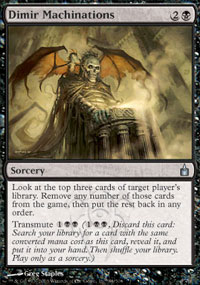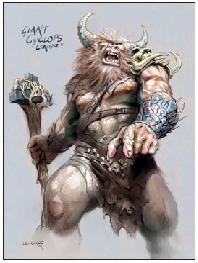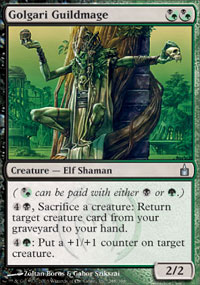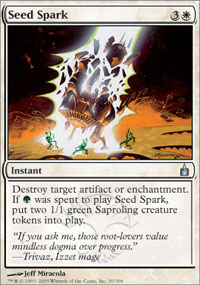
Those who regularly read the articles at mtg.com undoubtedly know that last week (or, at least, last week as I write this) was Selesnya week. On Monday, Mark Rosewater wrote an article in which he explained the fundamentals of the Green-White combination, following up his earlier articles about the fundamentals of each colour. Nine more articles about the other colour combinations will follow, but I thought I might as well compile his ten articles already and give you a summary of each of the ten guilds - or, in the case of the six guilds that aren't in Ravnica, a preview.
So, I'm going to take the colour pie, look at all those very important words on it that describe the philosophy and goal of each colour, and see how they intersect. What happens when a guild has to be two colours, when it has two philosophies, two meanings of life, two goals? It has to find a way to unite them all in one, clear idea, and this becomes the guild's identity. I'm going to try and discover these identities and share them with you.
Note that while I'll assume that the philosophy of each guild is exactly the same as the "general" philosophy of the colour combination, this may not always be true. The differences should be small enough though that this won't matter much.

A summary of this beautiful pie:
White - Keywords: Morality, Order. Goal: Peace. Means of achieving this: Law. Shortcoming: Uncreative.
Blue - Keywords: Logic, Technology. Goal: Omniscience. Means of achieving this: Intellect. Shortcoming: Inaction.
Black - Keywords: Parasitism, Amorality. Goal: Omnipotence. Means of achieving this: Selfishness. Shortcoming: Paranoia.
Red - Keywords: Chaos, Impulse. Goal: Freedom. Means of achieving this: Action. Shortcoming: Short-sighted.
Green - Keywords: Instinct, Interdependence. Goal: Growth. Means of achieving this: Nature. Shortcoming: Naïve.
I must say I think the guild system is the best idea they had for a Magic block, ever. I really like to explore how the philosophies of each colour pair overlap, and what this means for each guild, which is what I'm about to do.
The Allied Colour Pairs
The allied colour pairs are the simplest, so I'll start with these and keep the challenging bit for later.
Defining keywords: Interdependence + Morality = Selfless
Internal conflict: Impulse (Green sides with Red) vs Logic (White sides with Blue).
Goal: Growth + Peace = Expanding Community
Means: Nature + Law = Group Think
Despises: Selfishness
Strength: Resolve
Weakness: Naïve + Uncreative = Stagnant
The Selesnyans have been discussed by Mark Rosewater already, but for the sake of completeness I quickly mentioned the keywords of this guild. With Selesnya week just passed, there's not much reason to repeat it all. For a more detailed approach of this guild, read MaRo's article (after you finish mine, of course).

Defining keywords: Technology + Parasitism = Unnatural
Internal conflict: Order (Blue sides with White) vs Chaos (Black sides with Red)
Goal: Omniscience + Omnipotence = Total Control
Means: Intellect + Selfishness = Self-advancement and crippling others
Despises: Nature
Strength: Insightful (the smartest guild)
Weakness: Inaction + Paranoia = Unseen: fears the spotlights, doesn't want to come out of the shadows
House Dimir has a very clear goal. Know everything, control everything, be able to do everything, and you will totally dominate everything and everyone. Deploying yourself while at the same time stopping others from advancing towards their goal will make sure that in the long run, House Dimir will come out way ahead of the others. House Dimir despises nature and its instinctive reactions: controlling the world begins with controlling yourself.

Defining keywords: Impulse + Instinct = Direct
Internal conflict: Amorality (Red sides with Black) vs Morality (Green sides with White)
Goal: Freedom + Growth = Unhindered Expansion
Means: Action + Nature = Survival of the Fittest
Despises: Intellect
Strength: Active
Weakness: Short-sighted + Naïve = Unthinking
Things get really interesting when we move into unknown territory. The Gruul Clans are the first "guild" that doesn't show up in the Ravnica set. Their goal is unhindered expansion; translated to the city world of Ravnica this will essentially mean the destruction of the city itself. The Gruul Clans do not accept the city, the guild system, or anything at all about the plane, as it all hinders their growth. Their remedy to all this is simple: destroy. And they have the means to do this: no guild can match them in terms of raw power. They have the brute forces necessary to take down the city - but their weakness is their lack of thought, as well as the fact that they are predictable. Therefore they hate, fear and despise intellect - they know it can beat them, but as long as they can strike first and hard, the Gruul can win.
Defining keywords: Order + Logic = Passive
Internal conflict: Interdependence (White sides with Green) vs Parasitism (Blue sides with Black)
Goal: Peace + Omniscience = Controlled Balance
Means: Law + Intellect = Bureaucracy
Despises: Action
Strength: Long-Term Planning
Weakness: Uncreative + Inaction = Slow
This world is in a shaky balance. Any action can only serve to tip the scales and make Ravnica crash and burn. So says the Azorius Senate, and therefore their plan is to prevent anything at all from happening, and so preserve a controlled balance. They achieve this through careful, long-term plans and a slow bureaucracy. On every subject the Senate will take a passive, conservative stance. The Senate is in power now, and therefore, for them, any change can only be for the worse. The danger they face, however, is that their slowness, passivity and bureaucracy could hurt themselves too - if they can't react in time, they might get hit hard. Again, like pretty much every guild really, they fear what they despise: action can mean their doom.

Anarchy! So that's what the Rakdos look like!
Defining keywords: Amorality + Chaos = Anarchy
Internal conflict: Technology (Black sides with Blue) vs Instinct (Red sides with Green)
Goal: Omnipotence + Freedom = No Authority
Means: Selfishness + Action = Crime
Despises: Law
Strength: Creative
Weakness: Paranoia + Short-sighted = Irresponsible
Few guilds can be summarised in one word as easily as the Cult of Rakdos. Anarchy is their life, anarchy is their goal, anarchy is all they know. There is no crime the followers of Rakdos aren't willing to commit. Their greatest strength is their creativity and unpredictability. Combine red's "I like to have fun" and black's "I don't care about others" mentalities and you see that these criminals particularly like to have fun at the expense of others. Meanwhile they are absolutely not hindered by any sense of responsibility.
The Enemy Colour Pairs
For me, this is the fun part. What makes the enemy colour combinations so different from the allied combinations? First, their defining keywords aren't as closely related. For the allied combinations, they were the keywords lying next to each other on the colour wheel. Therefore they are rather easy to combine. For example, in Red-Green, Impulse and Instinct are already quite close to each other. When considering the enemy combinations, it won't be as easy to determine what the combination of the keywords means.
The second challenge lies in the internal conflict. The allied pairs had this conflict too, but there it was a matter of which side to choose in the fight between the respective allies, so it is an indirect problem. You may have noticed I didn't elaborate about this conflict; this is because, within the guild, the conflict doesn't really have to be solved. You can see it is a stress field within the colour combination - but not a major issue. This is different for the enemy coloured guilds. These guilds will actually have to find a way to unite two sides of a contradiction. They have to be night and day, odd and even.
So, for these guilds, the internal conflict will be a direct opposition, and this time I'll try to go in detail how the guild manages to be both sides of the same coin. The defining keywords of the enemy guilds are the keywords of each colour that aren't antonyms, so those that are closest to each other on the colour wheel.
Defining keywords: Impulse + Morality = Swift Justice
Internal conflict: Chaos vs Order
Goal: Freedom + Peace = Police State
Means: Action + Law = Aggressive Policing
Despises: Mind Control
Strength: Openness, Courage
Weakness: Short-sighted + Uncreative = Mental Block
On the surface, the Boros Legion seems quite simple. They have a military structure, they are the police of Ravnica, they want to bring justice and they act quickly. They can be aggressive in their policing, and their main weakness is quite typical for a well-drilled army: the inability to think outside of the box, a mental block which tells them to obey orders but inhibits further thought.
However, it's not all as simple. One thing that isn't entirely clear is the ultimate goal of the Boros. I believe their goal would be a strict police state. However, this seems to contradict the red ideal of freedom. Therefore, we have to look at what the guild despises: mind control, sneakiness, fighting shadows and lies. In short, House Dimir, the natural enemies of the Legion. This explains why they see a police state as essentially free; for them freedom means freedom of thought, and especially, freedom for the righteous. They will act aggressively against criminals, so that those who act according to the laws are free - within the police state of the Legion.
Finally, there's the internal contradiction of Red versus White: Chaos and Order. The Boros indeed manage to be both: they apply the law, creating order, but they often do this in a rather spontaneous, not completely correct way, and they won't always react in the same way to a similar crime. As such, they can be chaotic at the same time.

Defining keywords: Amorality + Instincts = Selfish Instincts
Internal conflict: Parasitism vs Interdependence
Goal: Omnipotence + Growth = Unstoppable Growth
Means: Selfishness + Nature = Parasites
Despises: Passivity
Strength: Undying
Weakness: Paranoia + Naïve = Inability to see a greater goal
This time, I'll start with the inner conflict, which seems quite appropriate for a guild continuously in conflict with itself. The Golgari Swarm unites parasitism and interdependence in a strange mix of feeding off each other, dying, being reborn off another's death... A never-ending cycle of life and death. One thing I like about Ravnica is how the guilds feel like the guilds when you play them, and this effect is the strongest for the Golgari in my opinion. When you are sacrificing creature to each other's effects, dredging and reanimating them, and discovering synergies you never had before in a sealed deck - that's when you realize how interdependence and parasitism can go together.
Do not make the mistake of seeing the Golgari as an entity. The Golgari Swarm are all individuals, following their selfish instincts to try and grow above the others. Elves, plants, wurms, dead and undead, an ever-changing, growing mass of individual beings. It should come as no surprise that the weakness of the Golgari is their inability to see a greater goal, and that their natural enemy is the never-changing, passive, long-term planning Azorius Senate.

The Izzet: always an opinion ready.
Defining keywords: Technology + Chaos = Chaotic Improvements
Internal conflict: Logic vs Impulse
Goal: Omniscience + Freedom = Unbound Knowledge
Means: Intellect + Action = Sudden Ideas
Despises: Brainwashing, any form of inhibiting the individual's thoughts
Strength: Fast thinking
Weakness: Inaction + Short-sighted = Going out-of-control
The Izzet are thinkers, but at the same time, they are impulsive. They can have sudden, great ideas, but that's where it often ends. They'll get to executing the idea, lose interest, get another bright idea and switch over to that. They often fail to control their own realizations.
Although not as selfish as Black, they value the individual highly. Therefore they despise the Selesnya Conclave - they consider them a mindless, brainwashed group. Knowledge and thought should be free, and nobody will ever tell an Izzet mage what his beliefs and ideas should be. As seen in the flavor texts of some cards already, Izzet mages have their own opinion about whatever they feel like having an opinion about - which is usually quite a lot.
Defining keywords: Order + Parasitism = Organised Thievery
Internal conflict: Morality vs Amorality
Goal: Peace + Omnipotence = Wealth
Means: Law + Selfishness = Taxes
Despises: Brute Force
Strength: Strong organisation and clear (selfish) goals
Weakness: Uncreative + Paranoia = Fear
I found the Orzhov Syndicate the hardest guild to understand. I have to admit I don't see how they can combine morality and amorality; few words are as opposite as these. I'd look for an explanation in the fact that they are a false religion, moral and amoral at the same time, but I can't say I see the complete picture there.
What is more clear, is the goal of the Syndicate, and how they achieve it. What they want is money. Their goal is wealth, luxury, jewels,... And they will use every possible way to get it. Ordinary thievery, taxes, blackmail, anything goes. The Orzhov are said to be involved in every financial transaction on Ravnica. They are also very well organized; they know what they're doing.
But under the surface of luxury and decadency lie hidden fears. They probably wouldn't admit it, but the Orzhov fear the other guilds. They believe they can rule them through controlling the money of the city, but at the same time they realize the weakness of that plan: brute force. Those who don't care about money can never be controlled by the Syndicate. Therefore they hate and fear the Gruul Clans.

A famous Simic mage: Dr Jekyll
couldn't control his own invention.
Defining keywords: Interdependence + Logic = Combined Knowledge
Internal conflict: Instinct vs Technology
Goal: Growth + Omniscience = Controlled Growth
Means: Nature + Intellect = Creating Lifeforms
Despises: Anarchy
Strength: Creation
Weakness: Naïve + Inaction = Overconfidence
And finally we get to the Simic Combine. The biomancers that originally had to look after nature on Ravnica, but ended up not only researching, but also trying to improve it. They experiment with nature, creating and studying new life forms, looking to steadily expand not only their knowledge of life, but also life itself. This explains how instinct and technology go together. Unlike the Izzet, they aren't individualist, but are looking to share their knowledge and combine it for a greater good.
The Simic despise anarchy, and therefore, the Cult of Rakdos. They want to create, but also keep their creations under their control; in fact, they want to control all life - without interrupting the growth. This is of course the obvious weakness in their plan; however, the Simic are overconfident and they don't believe they might be unable to control their creations.
Conclusion
As I said, I think the idea for Ravnica and its ten guilds was the best idea for a block so far. Colour combinations are just cool - maybe that's just me, but judging from the response to Ravnica, I think most people feel that way. I'm looking forward to see how the power struggle between these ten groups evolves in Guildpact and Dissension, and how the philosophy of the six upcoming guilds will translate to gameplay. If they do it as well as they did the first four, we're in for another great time!
- Tahn
Banner by ILoveAtogs
Edited by Goblinboy and Binary
Comments